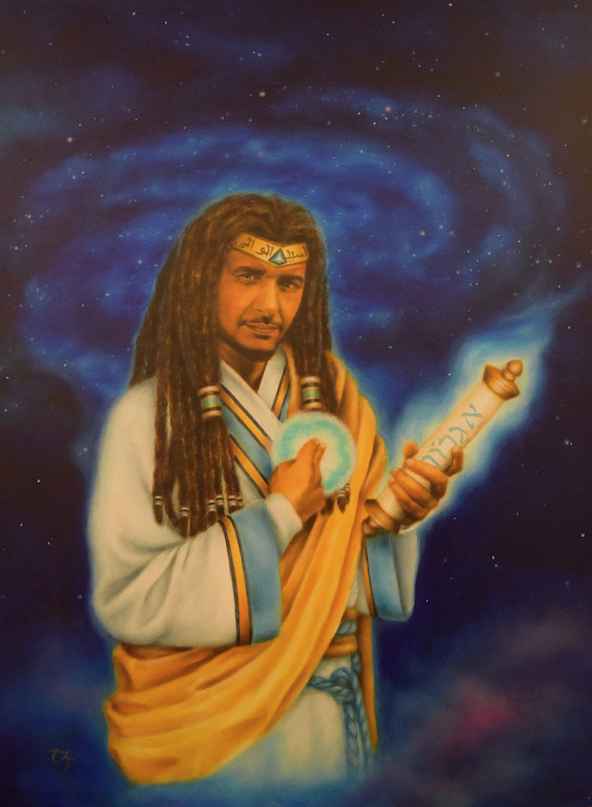Was John the Baptist Beheaded?
Special to Global News Centre
Countless works have been published pertaining to the false crucifixion of the son of Mary by Muslims, yet the false beheading of the son of Zachariah is largely ignored, why? —Ace Knight
We are told by an early historian, Josephus, that John the Baptist was put to death because of his political importance. The belief that he was is probably related to the New Testament story of his beheading at the behest of Salome, a story the truth of which we reject. Josephus does not mention the manner of his death.
Others have stated that he was beheaded. If it be true that John the Baptist was put to death by Herod Antipas on the suspicion of planning an insurrection as Josephus indicates, the punishment would not have been beheading. Under Roman law, only Roman citizens were sentenced to beheading. Any non-Roman citizen was sentenced to death by crucifixion for such activity.This was the case with Jesus, a non-Roman citizen, being accused of treason and sentenced to crucifixion. In addition, we see that when Paul was sentenced to die, he pleaded that he was a Roman citizen so that he would be beheaded and not crucified (Acts 22:27-28).
Certainly, if it is the case that John’s followers were many, spread far and wide, as it has been reported by some, and that Josephus mentions that the Jews were greatly moved by his words, and that Herod Antipas feared that John’s influence over the masses would cause a rebellious uprising leading to a revolt by the Jews against the Romans (Antiquities 18:5.2 116-119), then this would be in accord with the practice of capital punishment of said criminals under Roman law. That is, that non-Roman citizens be crucified.
As far as his being beheaded by Antipas, now believed to be a fiction, we know that records show Herod the Great lost his power to execute anyone. It is also known that he had to bring those whom he wanted to execute to the Roman authorities as he had lost his title of “Caesar’s Friend.”
With that in mind, there is nothing whatsoever showing that this power to execute prisoners was ever restored to his heirs one of whom was Herod Antipas. If Antipas had wanted to execute John the Baptist, he most likely would have needed permission from Rome to do so. If this be true, then the punishment would have to have been crucifixion and not beheading as this was reserved for Roman citizens.
Josephus’ account of the imprisonment and execution of John the Baptist would place it in the middle of the fourth decade, say 35 or 36 AD and therefore years after the events of the supposed crucifixion of Jesus, not before.
In the New Testament: An Islamic Perspective, Crook writes, “Josephus’ evidence creates a colossal chronological problem of enormous consequences.”
Subsequently, Pontius Pilate and Caiaphas were both removed in 36 AD. Where does the supposed crucifixion of Jesus fit in here exactly? The two principal characters in the gospels responsible for allegedly crucifying Jesus were no longer in power (Roman governor Pontius Pilate–Ant. XVIII, iv, 2; Caiaphas the High Priest–Ant. XVIII, iv, 3).
Consider the following examples of the way God dealt with his prophets in the Quran: “And, certainly, Noah cried out to Us. And how excellent were the ones who answer! And We delivered him and his people from tremendous distress. And We made his offspring—they, the ones who remain. And We left for him to say with the later ones: Peace be on Noah among the worlds. (Q. 37:79)
About Prophets Moses and Aaron: “And, certainly, We showed Our grace to Moses and Aaron. And We delivered them and their folk from the tremendous distress and helped them so that they, they had been the ones who are victors. And We gave them the manifest Book and guided them to the straight path. We left for them a good name with the later ones: Peace be on Moses and Aaron! (HQ 37:114-120)
About Prophet Lot: “Truly, he was of Our servants, ones who believe. And, truly, Lot was of the ones who are sent. We delivered him and his people, one and all, but an old woman of the ones who stay behind. Again, We destroyed the others.” (Q. 37:133-136)
About Prophet Jonah: “Then, the great fish engulfed him while he was one who is answerable. If he had not been of the ones who glorify, he would have lingered in expectation in its belly until the Day they are raised up.” (Q. 37:142-144)
All of them, plus Jesus, and Muhammad—as far as we know, all the prophets mentioned by name in the Quran were delivered from their enemies. Yet, the Prophet Yahya, whose name ironically means “He Lives”, is popularly supposed to have been put to death. Clearly, you can see how this story of the beheading creates an inconsistency with a text believed by muslims all over the world to be internally consistent.
It is my belief that Prophet Yahya was possibly put on the cross and not Jesus. However, he did not die on the cross. By God’s giving him the name of Yahya (“he who lives”) in the Quran and the Quranic fact that the Messiah was not crucified, but it appeared to the people as such, the Quran is telling us that that person was Chief Yahya (John the Baptist).
Chief Yahya (John the Baptist) survives as he lives out the words from God of “peace be upon him” as was the case with Prophet Abraham when he was thrown in the fire yet he was saved, “We said: O fire! Be coolness and peace for Abraham!” (21:69); hence: “Peace be on Abraham! Thus We give recompense to the ones who are doers of good! (37:110)”
John the Baptist died a natural death at some later time, as did Jesus. It is my belief from my understanding of the Quran that Yahya (John) was raised up in honor (rafa‘a) as was Jesus. Because this is not mentioned in the Quran, it does not mean that it could not have happened this way.
In fact, Roman law prohibited capital punishment at the hands of local courts such as those of the Jews. Capital punishment in any case had been made virtually impossible according Jewish law, which required that the two witnesses see each other, that the witnesses warn the perpetrator, etc.—all making it almost impossible that that Jews would have wanted to actually go through with an execution. Under Roman rule, Jews themselves, without Pilate, without the Romans, would never have been permitted to carry on capital punishment of anybody. -Prof. Lawrence Schiffman, New York University
Nelson’s Foundational Bible Dictionary, pg. 140
Lead Editor, Ph.D., Stanford University:
Ace Knight is a first generation American of Albanian descent. He is devoted to a few things. One is his family, another is his religion, and yet a third is intellectual and spiritual religious inquiry. His book is a tribute to this devotion and inquiry. It is a brilliant and original look at the Gospels and the Quran, as well as the earlier Mosaic texts. In this book, the self-taught Knight, with no formal education, points out linguistic and spiritual parallels between generations of key characters in three religious histories. A devout and inquiring Muslim, using the close reading of the Quran as his guide, Knight, is able to look back at the central story of the crucifixion through a new lens, the Muslim lens, using key passages from a number of religious scriptures to build a fascinating new argument. His thoughts, insights and interpretations are remarkable, profound, and leave the reader in awe.
Knight notices that a son is born to the prophet Zachariah at about the same time as a son is born to Mary. He systematically and spell-bindingly leads us through the parallels between these two prophets, the second of whom we have come to know as Jesus. Both are raised in secrecy, and bring prophesy and healing. Both are spared somehow the decree of Herod at birth, only to befall religious ostracism and apparent physical mutilation beheading/crucifixion at the time of apparent earthly death.
Knight takes us through the similarities in these prophet’s lives, their coming into the lives of their parents, as the sons had done, in response to prayer, or in the unlikely moment, for Mary, of her chastity. The coming together of Zachariah and Mary is cemented with the former shielding Mary from harm as her foster-father. Knight brings us back further in scriptural history to draw other such parallels when it comes to prophets, and he draws upon the Arabic roots of the names of these figures, from Adam to Zachariah’s son, to convince the reader of his novel contribution to scriptural reading. But I’m not going to give that away! For that, you must read the book yourself!
This book is slim, but both erudite and yet easy to follow, in its step by step progression through the many scriptures, seemingly so familiar is Ace Knight with every passage, the apt ones come easily to mind for him, and strike an immediate cord in us, no matter how familiar or unfamiliar we are with the text and story. And yet, this book is no recipe for persuasion. It is much more sophisticated than that. Written in a devout and true Muslim spirit, it is also—as mentioned at the beginning of this review—an inquiry and a wholly new contribution to that body of sculptural scholarship.
Ace Knight advances a theory which sheds an entirely novel light on the views that are commonplace today, and, through an examination of linguistics, passages, intent, and meaning, causes us to re-examine, in an exciting, clue-ridden way, what we have assumed to be true about the three major religions for centuries, concentrating on his own Muslim faith.
Dr. Mahmoud M. Ayoub
Professor of Islamic Studies and Christian-Muslim Relations Hartford Seminary, Hartford CT:
(This book) by Ace Knight is an engaging analysis of the life and mission of the two kindred religious personages, John the Baptist (Yahya) and Jesus (`Isa). Even though the central argument of the book, namely that the man who was hung on the cross was John and not Jesus, may be academically open to question as it rests on circumstantial evidence, the book will add much to the discussion of an epoch-making event that has shaped world history.
The book is informative and entertaining. It is certainly worth reading.
Award winning journalist Tim King:
If all of Ace Knight’s research and the conclusions he draws from it prove to be valid, then the traditional view of John the Baptist/Yahya, both scholarly and conventional, Jewish, Christian and Muslim, will be subjected to a tidal wave of revision and reconsideration. This will also affect most extant translations of the Quran into English, with the exception of The Sublime Quran by Dr. Laleh Bakhtiar which incorporates all of his results that relate to Quranic verses. Additionally, the great collections of medieval Islamic commentaries, both Sunni and Shia, which often repeat such colorful Biblical stories as the beheading of John the Baptist, will have to be viewed more critically. Such revisionism is sure to meet with a strong opposition.
Dr. Jay R. Crook Author of The Bible: An Islamic Perspective:
Ace Knight’s controversial book, vigorously challenges the conventional view of John the Baptist as little more than the baptizer of Jesus and the herald of his messiahship. The result of years of study, it expounds his revolutionary theories about the life, work, and significance of the neglected prophet. The John/Yahya that Work brings forth from the shadows of history is a major prophet in his own right, with an independent stature and mission. The book is a thought-provoking and fascinating re-examination of the prophet’s place in history.
M. Dennis Paul, Ph.D.
Creator of Thought Addiction programs:
I am impressed with the amount of detail Ace, as well his editor and good friend Jay Crook, have used in composing this remarkable thesis. No easy task, Ace sets about trying to justify, clarify, and rectify, as applicable, the disparities within various retellings of the history of John the Baptist and his relationship to Jesus the Christ. It is apparent to some that political movements of the time either changed, restricted or completely eliminated various contributions to the bible. It is conceivable that all such scriptural offerings in all the various religions underwent various pressures of a similar type.
Ace opens several windows with which to air questions and suggestions that might lead to greater reasoning, awareness and understanding… part of a great gift we often take for granted (or, in some cases, refuse to employ). It is telling that some men will welcome a flame with which they may explore caverns of thought previously cursed by darkness while others will curse the flame and cling to the walls of darkness swearing that this is all there is… and all that should be. My brother Ace is most definitely the former.
Roger H. Sigal, Trial Attorney – Tucson, Arizona
Mr. Knight has reflected an unparalleled inner commitment towards becoming a more spiritually-evolved and God-devoted person, and towards unraveling the truths and myths behind the Islamic, Judaic and Christian theologies. This substantial piece of scholarship is the result of the years of devotion to which Mr. Knight has dedicated himself, towards understanding, questioning, and seeking new perspectives on the religious traditions and issues of our times.
Robert Bangor, Ph.D.
I opened the book cautiously, expecting the polemics of yet another anti-Christian diatribe, but was surprised to find instead a reasoned academic examination of some aspects of early Christian history as preserved in the New Testament, the writings of Josephus, and elsewhere that cause me to reconsider the role of John the Baptist in the drama of Jesus the Messiah. Islamic sources are also explored. One may not agree with all of the book’s conclusions, but enough information is presented in the text and footnotes of this remarkable study to cause one to pause and rethink our assumptions about the importance of this relatively neglected prophet in the history of monotheism. An interesting read!
Prof. Patrick Dreier/Encore Music Academy
A More Likely Scenario. An Inspiring Read.
A well written and well thought out alternative to what was at best a problematic and most likely fictitious account of the personalities involved in the crucifixion. Knight’s evidence to support his supposition is very strong, much stronger than can be found in the new testament. A very enlightening and entertaining read.
Dr. Laleh Bakhtiar Resident Scholar Kazi Publications and first American woman to translate the Qur’an
(See The Sublime Quran and The Concordance of The Sublime Quran):
There are two methods of gaining knowledge in the great religious traditions of the world in general, and Islam, in particular. One method is knowledge that is imitated (taqlid) or transmitted by hearsay from generation to generation like the sciences of language, history and law. With this method, a person never asks “Why?” but accepts what is taught by an authority. In the Islamic tradition this leads to ijtihad, ijtihad specifically referring to developing expertise in jurisprudence (fiqh) to the level of being able to use independent judgment in understanding Islamic law (Shariah). Such a person is known as a mujtahid. Whoever is not a mujtahid, whoever has not reached that level, must “imitate” or “follow” a person who has, whether that person is dead (Sunni Muslims) or alive (Shia Muslims).
The second method of gaining knowledge is what is of most interest to us in this book review, that of tahqiq or intellectual knowledge where one may have a teacher for guidance but it is knowledge that cannot be passed from one generation to another. Each person has to discover it for himself or herself by “polishing the heart.” by becoming a person who sees with the eye of Oneness or tawhid, a person who deeply senses his responsibility to God, His creation and His humanity.
The person who gains knowledge with this method is called “a seeker of truth” (muhaqqiq). Intellectual knowledge (tahqiq) builds on transmitted knowledge but goes deeper. Transmitted knowledge includes memorizers of the Quran and the Hadith but only with intellectual knowledge can one understand what God and the Prophet are saying. Those who lack this intellectual endeavor have, one might say, not sought the means to see with the eye of “Oneness.”
Questions like “why” are not the only ones that the intellect of the seeker of truth asks because the underlying distinction is to think, “to think for oneself,” and not to stop at “imitation alone.” Not everyone has been burdened with this capacity as the Quran says in 2:286, but one person who has is Ace Knight. He is a seeker of truth, seeker of the Reality (haqq), a person who has verified knowledge, not on the basis of imitating the opinion of others, but on the basis of having realized the truth for himself as well as being one who acts in accord with haqq, all the time realizing his belief in the One God, the one creation and the one humanity.
A faith tradition may survive without a living mujtahid, but it rapidly disappears without a living muhaqqiq. Without a living seeker of truth, a seeker of reality, the faith tradition cannot remain faithful to its principles because it cannot understand those principles. A faith tradition may survive without a living mujtahid, but it rapidly disappears without a living muhaqqiq. Without a living seeker of truth, a seeker of reality, the faith tradition cannot remain faithful to its principles because it cannot understand those principles. Ace Knight’s basic premise is to follow the Quran and the New Testament which all assert that Jesus is the Messiah. However according to the Quran, it only appeared to the people who bore witness to the Messiah that he had been crucified.
In reality, according to the intellectual endeavor of the author, it was “he who lives” (Yahya), the Concealer of Secrets (hasura), as the Quran refers to him who was placed on the cross and lived.
The Concealer of Secrets concealed the secret of his identity and that of the Messiah in order to save the Messiah. The Messiah was then allowed to carry on his prophetic mission (perhaps traveling even as far as Kashmir where many believe that he is buried). At the same time that Mary retired to a sanctuary, Zechariah becoming her protector, Zechariah prayed for a heir. The son of Mary was close in age to the son of man (the Concealer of Secrets fathered by Zechariah). They may have even been cousins who resembled one another. They both began their prophetic mission around the same time yet neither revealed themselves as to who they actually were.
The author traces these and other parallels in the lives of the son of Mary and the son of man for a fascinating read. In the great tradition of seekers of truth in the past, Ace Knight brings harmony to ancient mysteries. He shows the possibility of how things may be in the Presence of the Oneness of God and he does so through scriptures – the Quran, and the New Testament.
This is a book that should be read by everyone who wants to discern the Reality of the story of the Messiah.



































Leave a Reply
You must be logged in to post a comment.